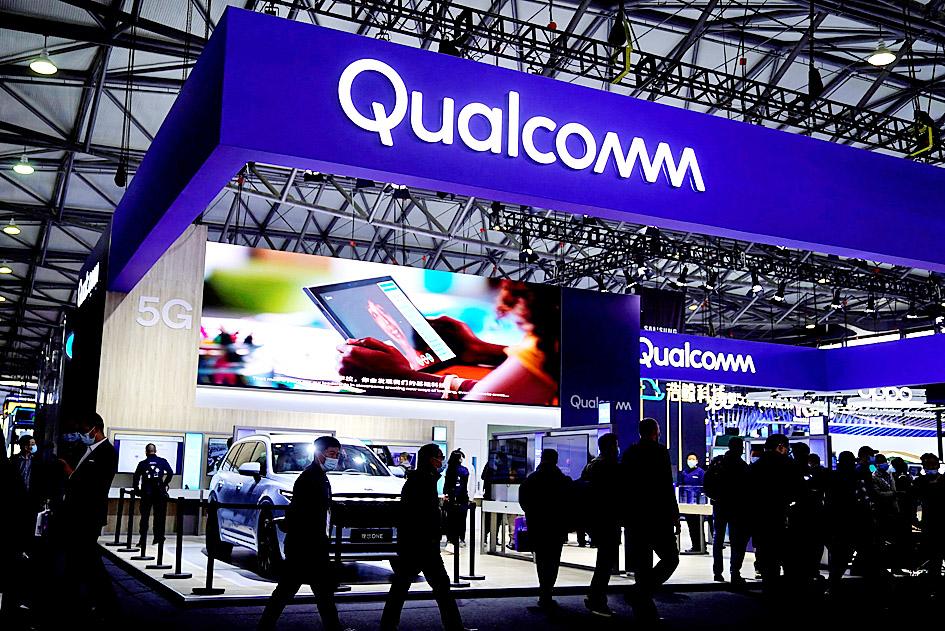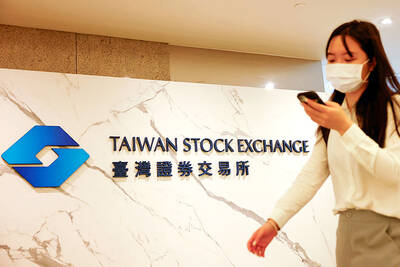Qualcomm Inc yesterday said it would maintain its supply chain strategy of sourcing chips from multiple foundry partners, including advanced chips from two major suppliers, to ensure a sufficient chip supply amid the COVID-19 pandemic.
Qualcomm is reportedly working with Taiwan Semiconductor Manufacturing Co (TSMC, 台積電) and Samsung Electronics Co on advanced products, such as 4-nanometer chips, for its new flagship 5G chips, the Snapdragon 8+ Gen 1 series.
Qualcomm is sourcing chips made by mature technologies from several foundry partners, the company said.

Photo: Reuters
Alex Katouzian, general manager of Qualcomm Technologies Inc’s mobile, compute and XR business, told a virtual media briefing that the strategy helped the firm deal with a chip shortage.
Qualcomm Technologies is a wholly owned subsidiary of Qualcomm.
Addressing concerns over weakening smartphone demand amid a slowing global economy and its ripple effects, Katouzian said a transition similar to the one from 3G to 4G is taking place in the transition from 4G to 5G, adding that the 5G penetration rate would keep growing.
DIFFERENT CONDITIONS
“Obviously, we are in a slightly different circumstance with the pandemic,” Katouzian said. “We see the penetration of 5G being extremely strong... We see a continuous growth path for 5G and the handset market as well.”
The company said demand for the overall smartphone market remains strong.
“There is some slowdown obviously because of the circumstances we are going through,” Katouzian said. “But we anticipate things to pick back up, but definitely not disappearing. We see still strength in the market, for sure.”
Qualcomm’s comments followed an optimistic MediaTek Inc (聯發科) projection about the 5G trend.
MediaTek expects the 5G penetration rate to rise to 50 percent this year, compared with 30 percent last year.
However, unlike MediaTek’s conservative view about the adoption of the millimeter-wave system due to costly base station deployment, Qualcomm expects the adoption rate to rise, citing its expanding use in a wide range of devices beyond smartphones and PCs, such as wearables, vehicles and XR headsets.
WI-FI 7 ADOPTION
Qualcomm also expects the adoption of new-generation Wi-Fi 7 technology to account for 10 percent of all devices next year or in 2024.
The company is shipping Wi-Fi 7 chips to customers and expects to see end products equipped with the chips by the end of this year, Rahul Patel, general manager of Qualcomm Technologies’ connectivity, cloud and networking business, said yesterday.
“You can see the Wi-Fi 6 adoption rate and how fast the ramp was. We anticipate Wi-Fi 7 to see a similar uptick in those adoptions,” Patel said, expecting a majority of premium Android smartphones to adopt Wi-Fi 7 technology next year.
This year, global shipments of devices equipped with Wi-Fi 6 technology would rise to more than 2.3 billion, Patel said.

ADVANCED: Previously, Taiwanese chip companies were restricted from building overseas fabs with technology less than two generations behind domestic factories Taiwan Semiconductor Manufacturing Co (TSMC, 台積電), a major chip supplier to Nvidia Corp, would no longer be restricted from investing in next-generation 2-nanometer chip production in the US, the Ministry of Economic Affairs said yesterday. However, the ministry added that the world’s biggest contract chipmaker would not be making any reckless decisions, given the weight of its up to US$30 billion investment. To safeguard Taiwan’s chip technology advantages, the government has barred local chipmakers from making chips using more advanced technologies at their overseas factories, in China particularly. Chipmakers were previously only allowed to produce chips using less advanced technologies, specifically

BRAVE NEW WORLD: Nvidia believes that AI would fuel a new industrial revolution and would ‘do whatever we can’ to guide US AI policy, CEO Jensen Huang said Nvidia Corp cofounder and chief executive officer Jensen Huang (黃仁勳) on Tuesday said he is ready to meet US president-elect Donald Trump and offer his help to the incoming administration. “I’d be delighted to go see him and congratulate him, and do whatever we can to make this administration succeed,” Huang said in an interview with Bloomberg Television, adding that he has not been invited to visit Trump’s home base at Mar-a-Lago in Florida yet. As head of the world’s most valuable chipmaker, Huang has an opportunity to help steer the administration’s artificial intelligence (AI) policy at a moment of rapid change.

The New Taiwan dollar is on the verge of overtaking the yuan as Asia’s best carry-trade target given its lower risk of interest-rate and currency volatility. A strategy of borrowing the New Taiwan dollar to invest in higher-yielding alternatives has generated the second-highest return over the past month among Asian currencies behind the yuan, based on the Sharpe ratio that measures risk-adjusted relative returns. The New Taiwan dollar may soon replace its Chinese peer as the region’s favored carry trade tool, analysts say, citing Beijing’s efforts to support the yuan that can create wild swings in borrowing costs. In contrast,

TARIFF SURGE: The strong performance could be attributed to the growing artificial intelligence device market and mass orders ahead of potential US tariffs, analysts said The combined revenue of companies listed on the Taiwan Stock Exchange and the Taipei Exchange for the whole of last year totaled NT$44.66 trillion (US$1.35 trillion), up 12.8 percent year-on-year and hit a record high, data compiled by investment consulting firm CMoney showed on Saturday. The result came after listed firms reported a 23.92 percent annual increase in combined revenue for last month at NT$4.1 trillion, the second-highest for the month of December on record, and posted a 15.63 percent rise in combined revenue for the December quarter at NT$12.25 billion, the highest quarterly figure ever, the data showed. Analysts attributed the